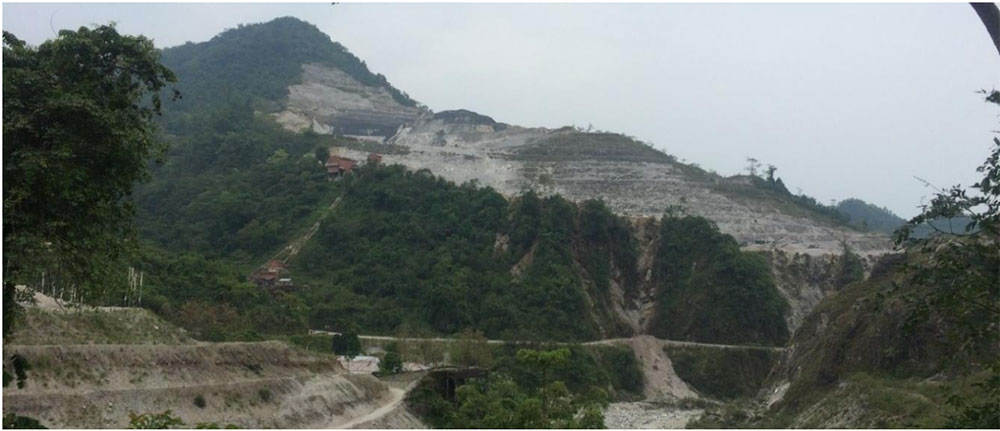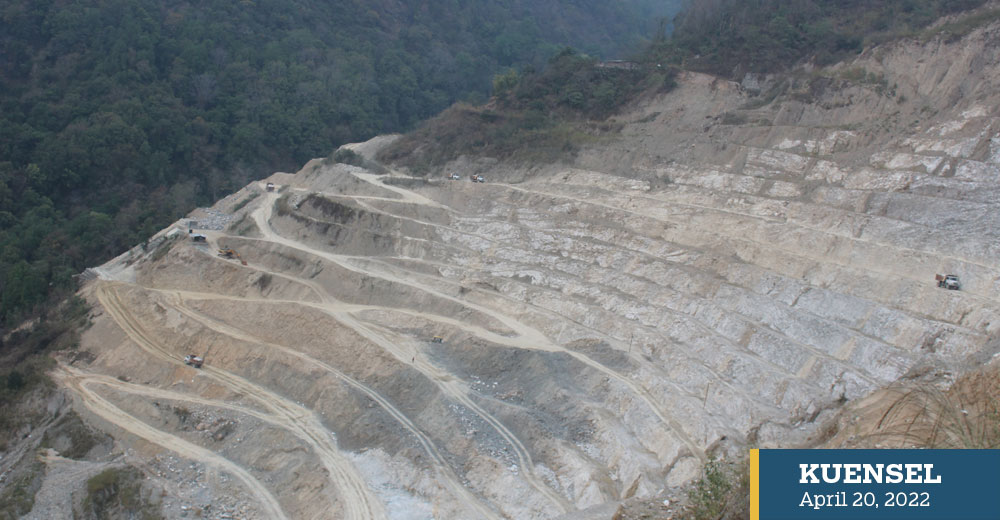Rinzin Wangchuk
Based on wider economic benefits, high potential for export in primary form, potential for generating substantial revenue and sustainable development of mineral resources, the government has allocated the Khothakpa gypsum mines and the Chunaikhola dolomite mines to the state-owned mining agency this week.
State Mining Corporation Limited (SMCL) will operate dolomite mines in Samtse and gypsum in Pemagatshel for 15 years after signing the mining lease agreement between the Department of Geology and Mines (DGM) and SMCL.
On Monday, April 18, Economic Affairs (MoEA) Secretary Karma Tshering and Chief Executive Officer of Druk Holding and Investments Limited (DHIL), Dasho Karma Yezer Raydi, signed the memorandum of understanding (MoU) handing over the mines to SMCL.
Both the gypsum mines in Khothakpa in Shumar gewog, Pemagatshel and the Chunaikhola dolomite mines in Phuntshopelri gewog, Samtse are currently being operated on an interim lease by SMCL.
MoEA secretary Karma Tshering said that the decision to lease these two mines to SMCL was based on section 10 of the Mines and Minerals Management Act of Bhutan 1995 and section 27(1) and 28 of the Mines and Minerals Management Regulations 2022.
During the lease period, SMCL will pay a mining license fees of Nu 3 billion (Nu 200 million a year) for the Chunaikhola dolomite mines and Nu 1.125B (Nu 75M a year) for Khothakpa gypsum mines to the government.
The MoU, according to the statement from MoEA, is expected to promote socially responsible and environmentally friendly sustainable mining while contributing huge revenue to the State. The MoU also has the provision for other areas of cooperation for future development of minerals and the sector with clear roles and responsibilities of the parties.

Chunaikhola
Dolomite and gypsum mines
After the government announced the cancellation of auctioning the dolomite mining rights in view of the Covid-19 pandemic in 2020, SMCL began to work on the transition. SMCL’s CEO Kezang Jamtsho said that the operations of dolomite began in October 2020 and SMCL exported 1.98 million metric tonnes of dolomite in 2021.
He said that SMCL had to absorbed a large number of employees and machineries from Jigme Mining Corporation Ltd (JMCL), which mined the deposits in Chunaikhola for 15 years with a total bid value of Nu 390 million. The lease period was completed in May, 2020.
The main market for Chunaikhola dolomite are premier steel sectors in India like Bokaro Steel Plant, Durgapur Steel Plant, Tata Steel Ltd and more than 100 units of Ferro Alloys and Sponge Iron Plant. JMCL used to export about 2.6 million MT in a year.
To maintain business continuity and reap more benefits, the geological reassessment of the dolomite deposit in and around Chunaikhola was undertaken by DGM for a period of three months from February to May 2019. It was found that the area has a reserve of 592.692 million MT up to an elevation level of 420m.
Considering 15 to 20 percent average increase in annual mine production from 2018 with a mine production rate of around 3 million MT of dolomite, the deposit is expected to last 169 years based on the geological reserve.
JMCL had extracted more than 21.436 million MT of dolomites from 2005 to 2019.
There were three active dolomite mines before the auction in 2005. Chunaikhola dolomite mine was operated by Bhutan Dolomite Mine, Sunargaon dolomite mine by Jigme Mining Enterprise, and Khagrakhola dolomite mine by Chhundu Enterprise.
The government handed over the Khothakpa gypsum mine to SMCL for an interim period of two years from January 1, 2019, immediately upon the expiry of gypsum lease to Druk Satair Corporation Ltd (DSCL).
SMCL made a net profit, after tax, of Nu 336.35M due to support and co-operation from DSCL with 100 percent employees during the takeover. DSCL mined gypsum with a bid value of Nu 413.50M for a period of 15 years from 2004 to 2018.
CEO Kezang Jamtsho said that SMCL was also operating coal mines in the belt that stretches from Nganglam to Daifam, since 2016. The five year lease period was signed in 2020.
New Mining regulations
The Mines and Minerals Regulations 2022, which was adopted by the government in February this year addresses most of the issues including corporate social responsibility (CSR) and mineral wealth going to the hands of a few.
In an earlier interview, economic affairs minister Loknath Sharma said that there was no clarity on CSR in the old regulation and that only a few large companies implemented it. Lyonpo had said that while the large and strategic mines have been leased to SMCL, the private players can apply for smaller mines.
The new regulation does not mandate the proponent to float shares to the public. To introduce legal provisions to make it mandatory for mining companies to float shares to the public was an option to distribute the mining wealth among people.
The new regulation has done away with the sealed/open tendering process, which was mandated by the old regulation in case the government decided to lease a pre-identified mineral deposit for commercial exploitation.
The new regulations also allows the economic affairs ministry to allocate mineral reserves directly to state-owned mining agencies or a Bhutanese citizen as an individual or a proprietor of a licensed firm, or a company.


